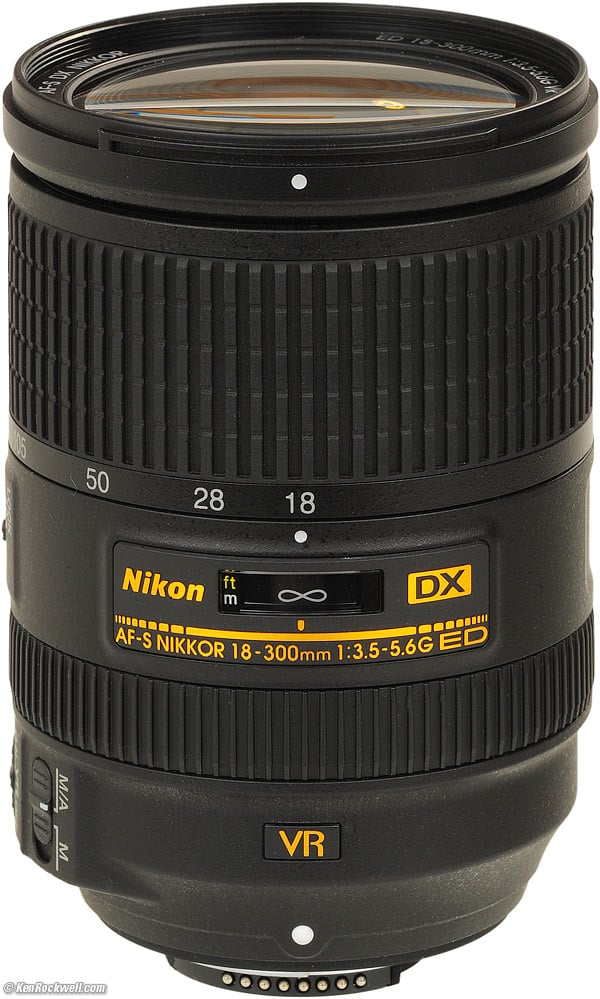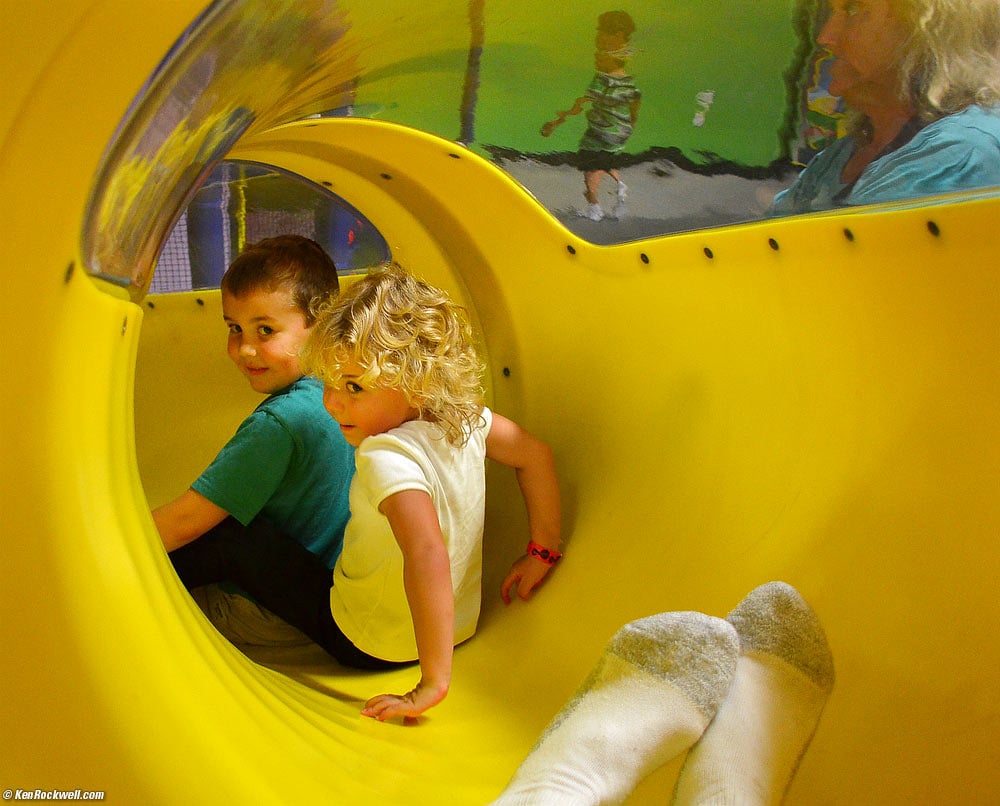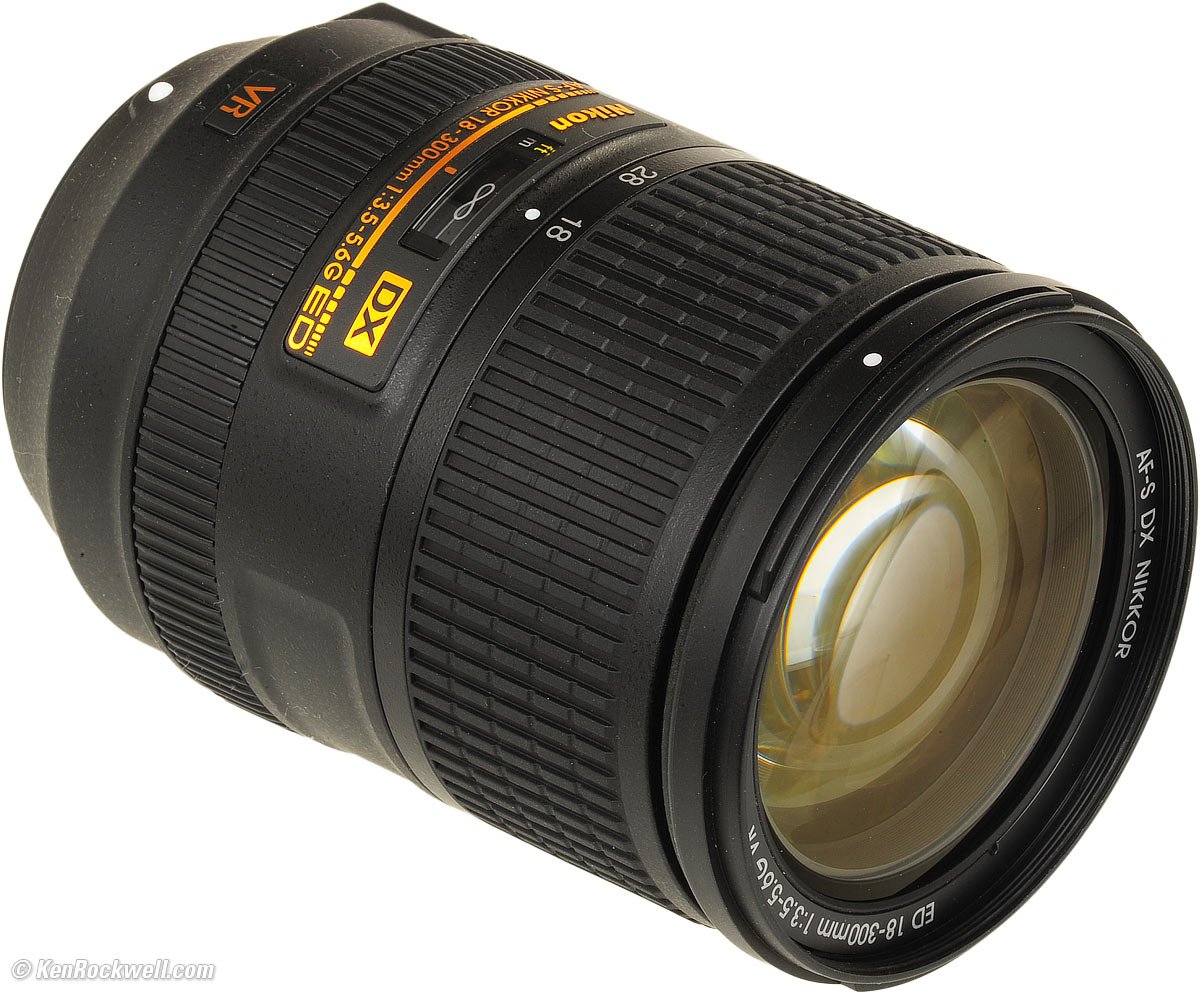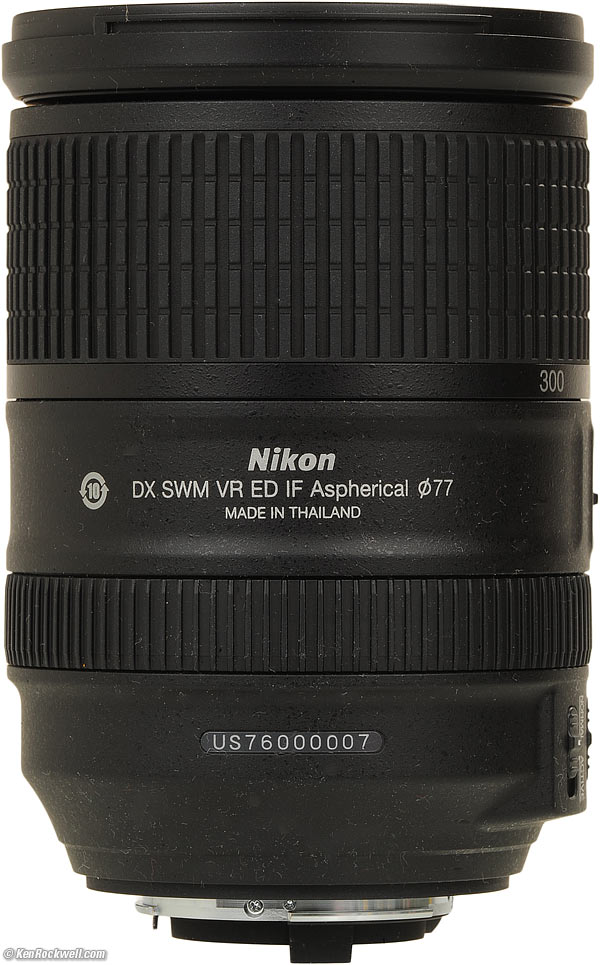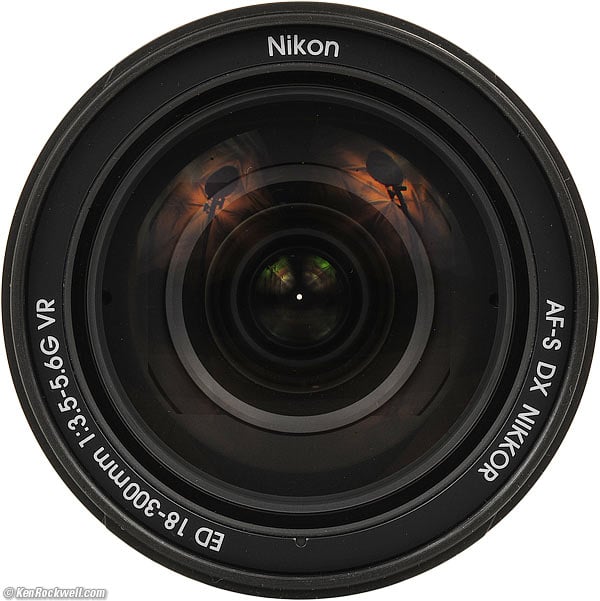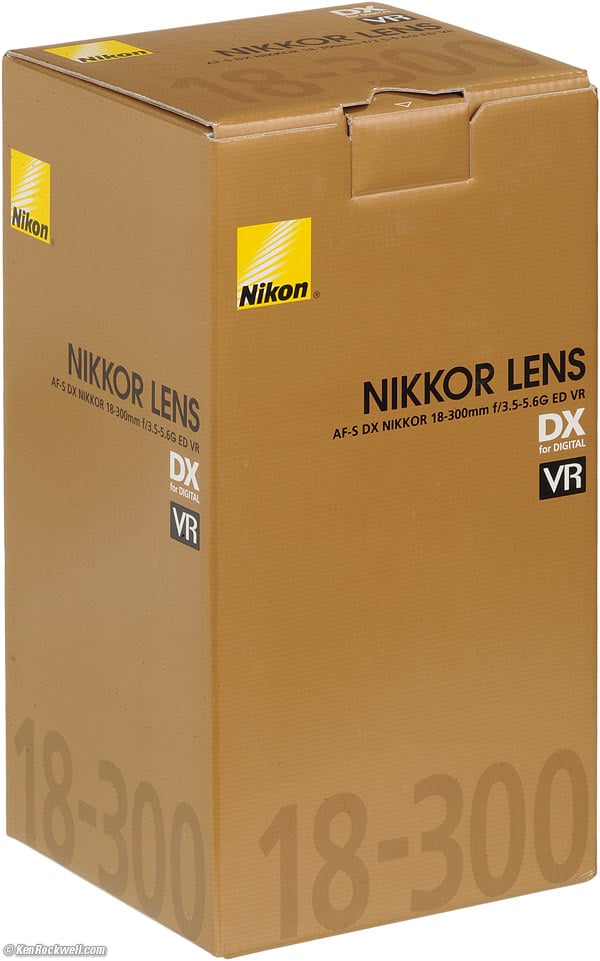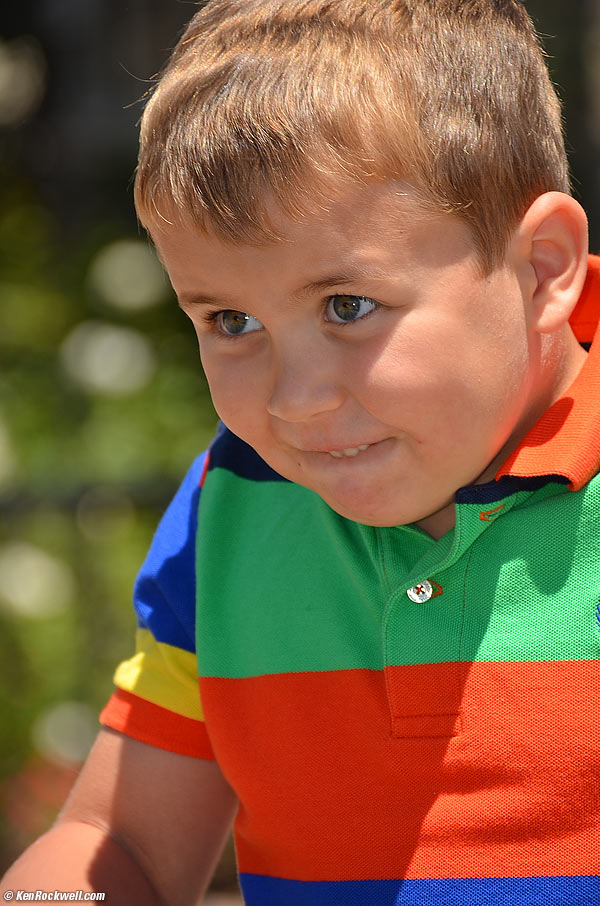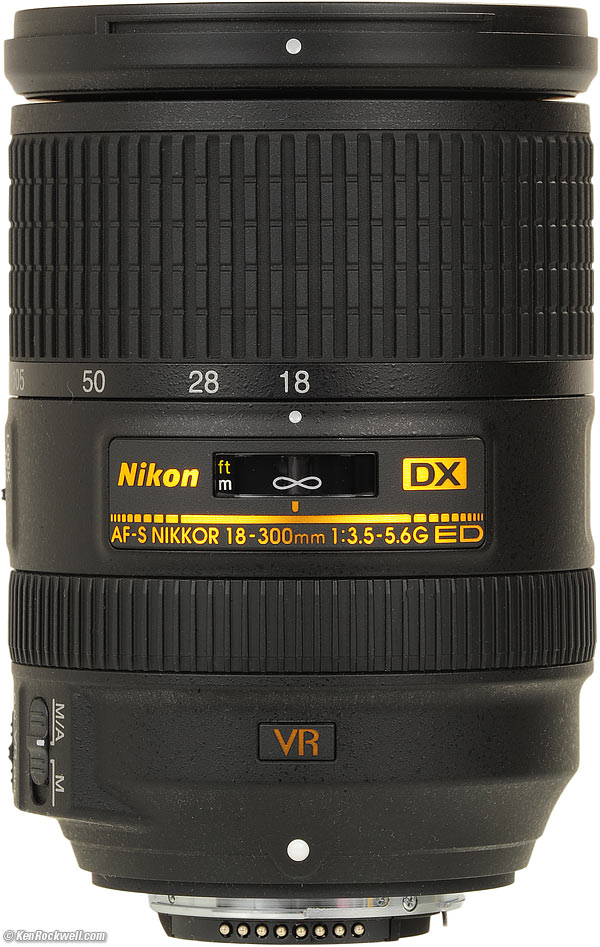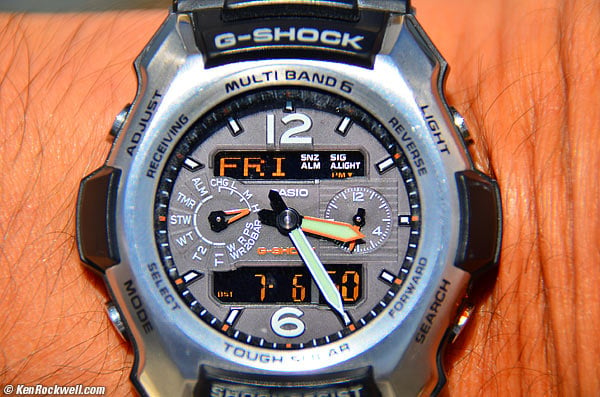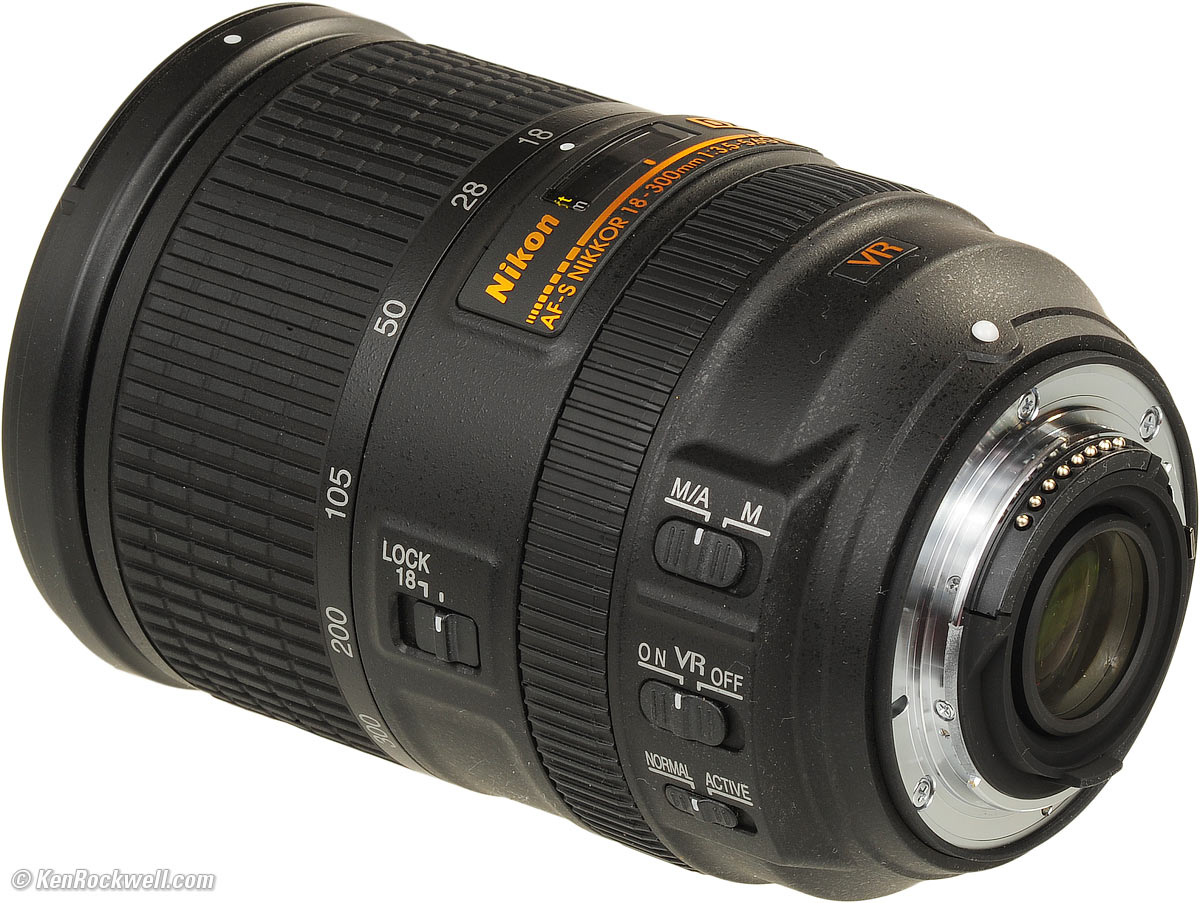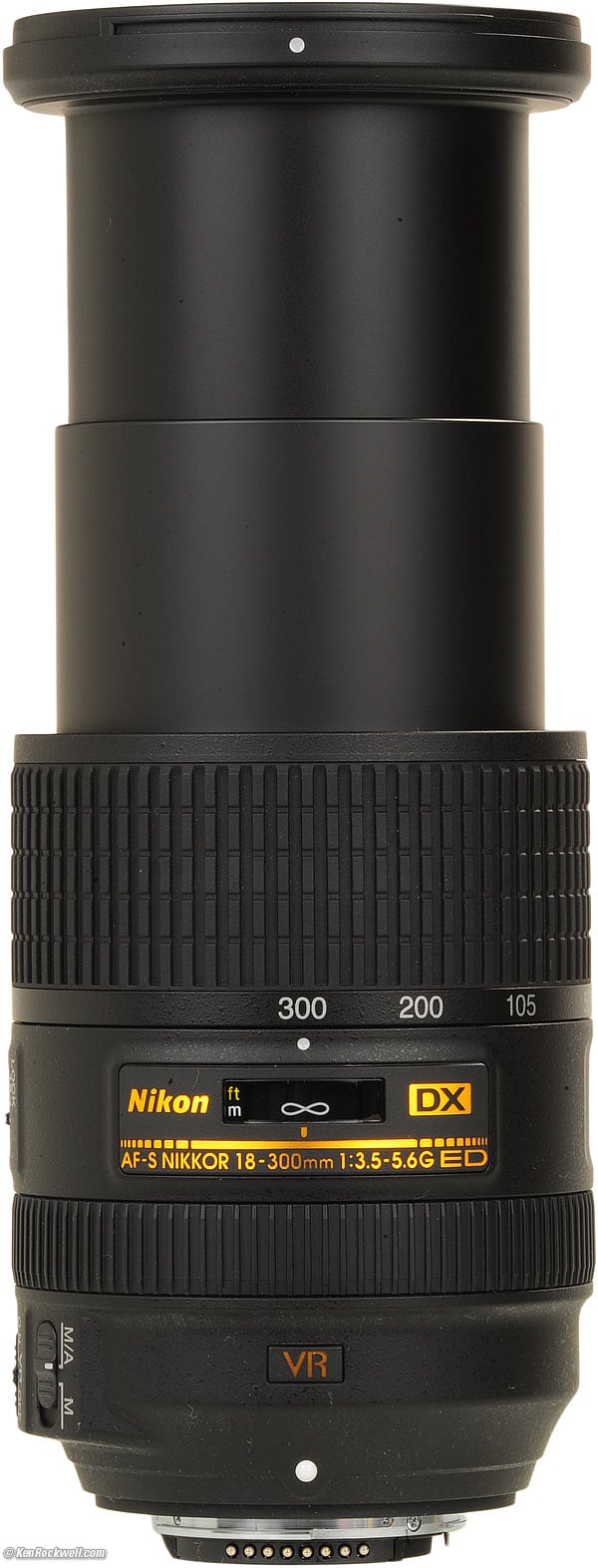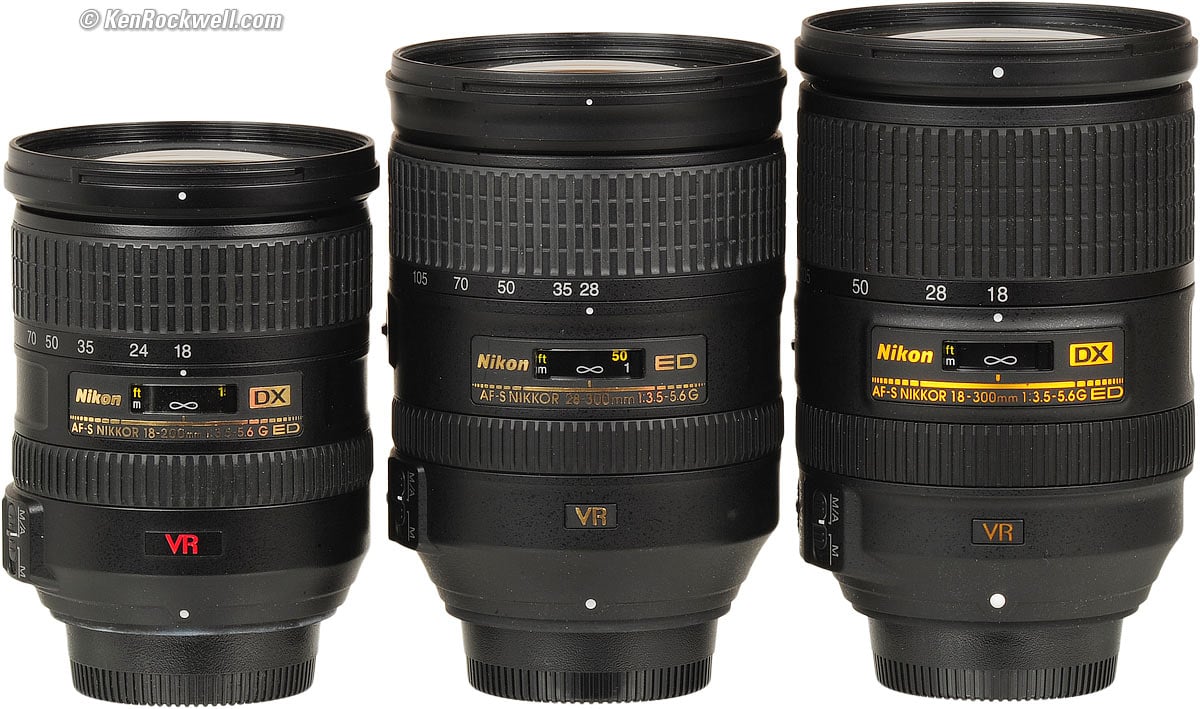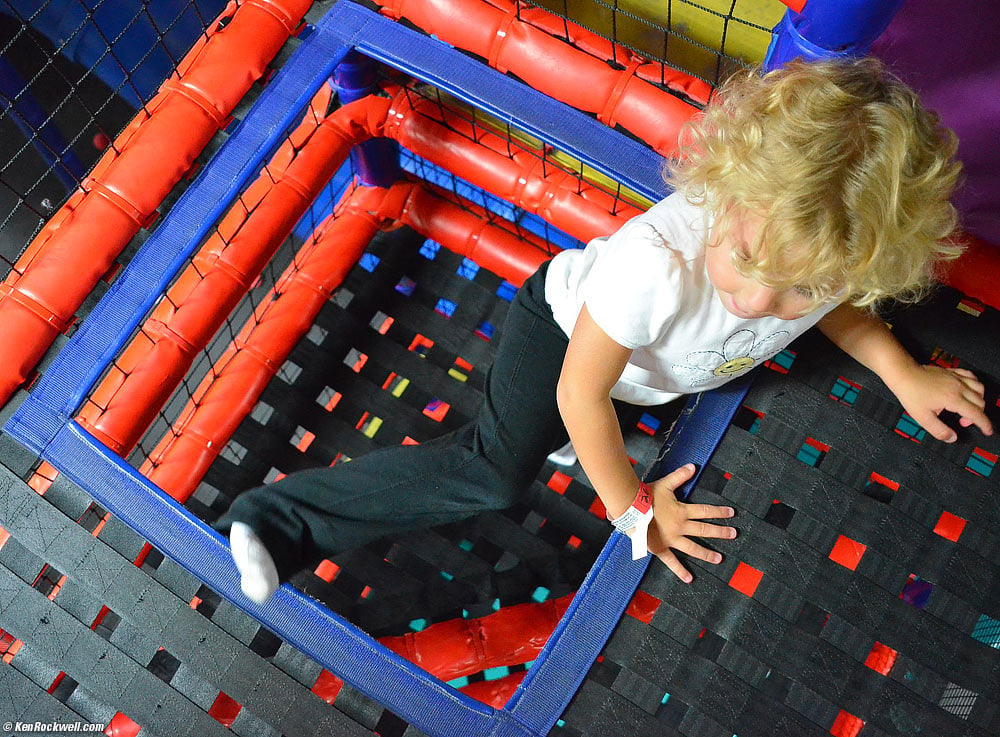Home Donate New Search Gallery Reviews How-To Books Links Workshops About Contact
Nikon 18-300mm VR
DX AF-S G ED NIKKOR
OBSOLETE. Replaced by the 18-300mm f/3.5-6.3 VR
Intro Specs Performance Usage Compared Recommendations More
Nikon 18-300mm VR (replaced by today's 18-300mm, was DX only, 77mm filters, 29.2 oz./828g, 1.5'/0.45m close focus, about $500 used if you know How to Win at eBay, or you can get it at Amazon.) bigger.
This all-content, junk-free website's biggest source of support is when you use those or any of these links to approved sources when you get anything, regardless of the country in which you live. Thanks for helping me help you! Ken.
May 2013 Nikon Reviews Nikon Lens Reviews All Reviews
NEW: Nikon 18-300mm f/3.5-6.3 VR Ten ounces lighter than this lens, and less expensive, too!
NEW: Nikon 18-200 vs. 28-300 vs. 18-300 Comparison July 2012
Ideal for: Perfect for use on DX digital as a do-everything lens.
Not for: This lens is too big and heavy for me. The whole point of a DX system is small size. Personally, I prefer the smaller and lighter 18-200 VR, and crop in the rare cases I need 300mm.
Sample Image File
Yogurt taps. (D7000 at ISO 100, 18mm at f/3.5 at 1/50). Full-size © 3.5 MB JPG.
I licenced this image to McDonalds, and they used it on a BILLBOARD. Enough said?
Ryan, Katie and Dada sliding down the slide, 07 July 2012. (Nikon D7000, Nikon 18-300mm VR at 25mm, program auto gave f/4 at 1/125 at Auto ISO 2,000, Matrix meter, STANDARD Picture Control at +1 Saturation, 6 sharpening, A3 AWB.) bigger.
Introduction top
Intro Specs Performance Usage Compared Recommendations More
|
Adorama pays top dollar for your used gear. I use these stores and ScanCafe. I can't vouch for ads below.
|
The Nikon 18-300mm VR is an extension from the now classic all-in-one Nikon 18-200mm VR.
It does the same thing, except goes all the way to 300mm. It performs extremely well at all focus lengths, but does get a bit softer at 300mm — but still sharper than cropping from the 18-200mm at 200mm.
This new 18-300mm lens is much heavier (830g versus 565g) and longer (120mm versus 96mm) than the 18-200mm VR, which has already gotten too heavy for me to want to carry around all day.
This new 18-300mm also offers Vibration Reduction (4 stops) and instant manual-focus override.
This lens works only on Nikon DX cameras.
Yes, it will shoot on FX cameras, but the corners will always be cut-off. Nikon offers a trick "crop" mode in their FX cameras as a sales incentive to remove the dark corners and only use the middle of the sensor, but you throw away more than half an FX camera's resolution, and have to peep through a small cut-out in the center of the viewfinder.
Nikon offers the DX crop mode on FX cameras more as a trick to get people to buy Nikon FX cameras, thinking that they'll be able to use their existing DX lenses. When people do, they quickly discover that the crop mode is a crock, and wind up buying all new FX lenses anyway. Nikon does this to make it seem like it's less expensive to stay with Nikon than to change to Canon when stepping-up to full-frame, and this trick works for Nikon.
If you see FX in your future, don't be buying a lot of DX lenses.
On 35mm, the corners will always be black at every setting, with maximum coverage at 50mm, where only a small bit of the corners are cropped off.
Pricing & Availability intro top
$999.95, May 2013.
$999.95 at introduction, June 2012.
Available: Since late June 2012.
Nikon 18-300mm VR. enlarge.
Specifications top
Intro Specs Performance Usage Compared Recommendations More
Name top
Bottom, Nikon 18-300. bigger
Nikon calls this the AF-S DX NIKKOR 18-300mm f/3.5-5.6G ED VR.
AF-S and SWM: Silent Wave Autofocus Motor.
DX: Won't work well on film or FX cameras.
NIKKOR: Nikon's brand name for all their lenses.
G: Gelded for cost-reduction and removing compatibility with older cameras.
ED: Magic Extra-low Dispersion Glass.
VR: Vibration Reduction. Claims almost 4 stops improvement.
IF: Internal focusing; nothing moves externally as focused.
Aspherical: Specially curved glass to give even sharper pictures.
∅77: 77mm filter thread.
↓10↑: Lead-free RoHS solder used so that tin "whiskers" will grow after about ten years, ensuring that its circuitry is unrepairable, thus a 10-year expected life before being thrown away as unrepairable. More on tin whiskers from NASA and more here (page 41).
Optics top
Nikon 18-300mm VR internal diagram: Aspherical ED.
19 elements in 14 groups.
3 ED glass elements.
3 Aspherical elements.
There is a small flare shield behind the front group reminiscent of the same in the Canon 20-35 USM.
Sharpness top
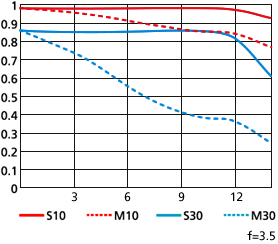 |
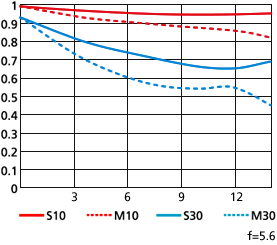 |
Nikon 18-300mm VR MTF at 18mm. |
Nikon 18-300mm VR MTF at 300mm. |
Diaphragm top
Nikon 18-300mm VR.
9 rounded blades.
Stops down to f/22-32.
Coverage top
DX only.
Focal Length top
18-300mm.
When used on a DX camera, it gives angles of view similar to what a 28-450mm lens gives when used on an FX or 35mm camera.
Angle of View top
76° ~ 5.3° on DX.
Close Focus top
1.5 feet (0.45m) from the image plane.
Maximum Reproduction Ratio top
1:3.2 (0.31x).
Hard Infinity Focus Stop? top
No.
You have to let the AF system focus at infinity.
Focus Scale top
Yes.
Depth-of-Field Scale top
No.
Infra-Red Focus Index top
No.
Aperture Ring top
No.
Filter Thread top
77mm, plastic.
Does not rotate, but pumps in and out with zoom
Vibration Reduction (VR) top
Claims 4 stops improvement.
Size top
Nikon specifies 3.3" (83 mm) diameter by 4.7" (120 mm) extension from flange.
Weight top
29.213 oz. (828.2g), measured.
Nikon specifies 29.3 oz. (830 g).
Hood top
Plastic bayonet HB-58 hood, included.
Case top
Silly CL-1120 pouch included.
Included top
Snap-on front lens cap.
LF-4 rear cap.
HB-58 plastic hood.
CL-1120 sack.
Quality top
Made in Thailand.
Warranty top
5 years, USA.
Packaging top
Gold-colored microcorrugated cardboard box.
Folded microcorrugated cardboard innards to hold lens, hood and sack.
Box, Nikon 18-300mm VR.
Announced top
12:01 AM, 14 June 2012, New York City Time.
Promised top
Late June 2012.
Available since top
Early July 2012.
Price, USA top
June 2012 ~ May 2013: $1,000.
Performance top
Intro Specs Performance Usage Compared Recommendations More
Overall Autofocus Bokeh Color Distortion Ergonomics
Eyeblow Falloff Filters Focal Lengths, effective Focus Breathing
Ghosts Hood Lateral Color Fringes Macro Maximum Aperture
Mechanics Sharpness Sounds and Noise Spherochromatism
Sunstars Survivability Zooming
Overall performance top
The Nikon 18-300mm VR is a very competent ultra zoom. My biggest complaint is its size and cost.
Autofocus performance top
Overall
AF is reasonably fast enough, and it's accurate.
AF Speed
AF speed isn't that fast, but I expect this due to the huge zoom range.
It works fine at every distance and focal length setting, but might not be as fast as a lens that doesn't have to cover such a huge range of distances at such long focal lengths.
AF Accuracy
AF was always accurate.
Manual Focus
Manual focus is wonderful: just flick the ring with a fingertip.
Bokeh performance top
Bokeh, the character of out of focus backgrounds, not simply how far out of focus they are, is good to neutral.
Out-of-focus backgrounds never distract. The rounded 9-bladed diaphragm ensures that blur circles are always round and not polygons.
Ryan's funny face. 18-300 at 300mm at f/7.1 on D7000.
Color Rendition performance top
The color rendition is the same as my other Nikkor AF lenses.
Distortion performance top
The Nikon 18-300mm VR has boatloads of distortion as expected. It's got wild barrel distortion at 18mm, and wild pincushion distortion from 28mm and longer. The good news is that recent digital cameras like the D90, D3100, D3200, D5000, D5100, D7000, D4, D800 and D800E can be set to correct the distortion automatically in-camera (be sure you have the latest Lens Data, L 1.006 or newer, loaded in your camera from Nikon).
In-camera correction does a great job from 28mm and longer. Shorter than 28mm, in-camera correction doesn't correct completely, but the great news is that it corrects the heinous higher-order distortion, leaving an easy-to-correct image with only first-order distortion. Even at its worst at 18mm, if you use in-camera correction, it's easy to correct fully with Photoshop's lens distortion filter.
Using these factors on images made without in-camera correction still leaves higher-order waviness on images made at 28mm and shorter.
These aren't facts or specifications, they are the results of my research that requires hours of photography and calculations on the resulting data.
On DX at 10' (3m) |
Correction factor with uncorrected images |
Correction factor to use with images made with correction ON in D7000 |
18mm |
+5** |
+3.2 |
28mm |
-3.5* |
-0.7 |
50mm |
-3.4 |
0.0 |
105mm |
-3.8 |
-0.5 |
200mm |
-3.0 |
-0.5 |
300mm |
-2.5 |
0.0 |
© 2012 KenRockwell.com. All rights reserved.
* Some waviness remains.
** Much waviness remains.
Ergonomics (handling and ease-of-use) performance top
Nikon 18-300 DX VR.
Ergonomics are perfect, if you don't mind the size.
The front third of the lens is zoom ring.
The focus ring is always right under your fingertips.
The M/A - M AF slide switch is always right under your thumb.
Eyeblow performance top
As the 18-300mm VR is zoomed in and out, air pumps in and out, and you may have some air blow out of the eyepiece into your eye.
You won't usually care, but the design of the 18-300 VR is such that air, and thus dirt, are pumped in and out all the time into both your lens and your camera as you zoom.
Falloff (darkened corners) performance top
Falloff on DX is minor. It's good at the wide end (some falloff helps make wide shots stronger), and there's no falloff in the middle of the zoom range.
As expected, there is some falloff at the long end, which is not good. Long shots ought not to have falloff. You'll rarely see this, but you will see it at the long end if most of your shot is the sky. This might annoy you if you're snapping birds or plans and can't fill the frame.
I've exaggerated this by shooting a gray field and placing these on a gray background:
Nikon 18-300mm VR falloff on DX at infinity, no correction.
© 2012 KenRockwell.com. All rights reserved.
|
Filters, use with performance top
There is no problem with vignetting, even with very thick filters.
In fact, even two stacked filters usually work fine without vignetting even at 18mm on DX.
The filter ring never rotates.
Focal Lengths, effective performance top
The effective maximum focal length shortens at distances closer than infinity in order to allow this lens to focus as close as it does.
Here are my observations, comparing other lenses to the 300mm setting at various distances.
Distance |
Effective focal length at 300mm setting |
Infinity |
300mm |
10 feet (3m) |
200mm |
5 feet (1.5m) |
155mm |
So yes, at 1.5 feet, this 18-300mm is really only a 155mm lens. Tough; this is the only way to get a lens to focus this close.
Focus Breathing performance top
Of interest mostly to cinematographers focusing back and forth between two subjects, the image from the Nikon 18-300mm VR gets smaller as focused more closely. This effect is strongest at the longest focal lengths, where this is done to allow very close focusing distances.
Ghosts performance top
I've never seen any ghosts in this lens, but I haven't pushed it, either. Ghosts haven't been much of a problem in a long time.
Hood performance top
The plastic hood is included. I doubt it does much good; I never use these.
Lateral Color Fringes performance top
There are very few lateral color fringes on the D7000, which corrects them automatically.
If you look really close, there is just the slightest yellow-blue in the corners at 18mm, none at 28mm, slight at 50mm, none at 105mm and longer.
Macro performance top
It focuses very close, but if you want to make huge enlargements, it's not that sharp. In the sample below, know that limited depth-of-field is why the watch bezel and my skin are softer, not from lens softness.
At closest focus (1.5 feet) at 300mm on DX D7000.
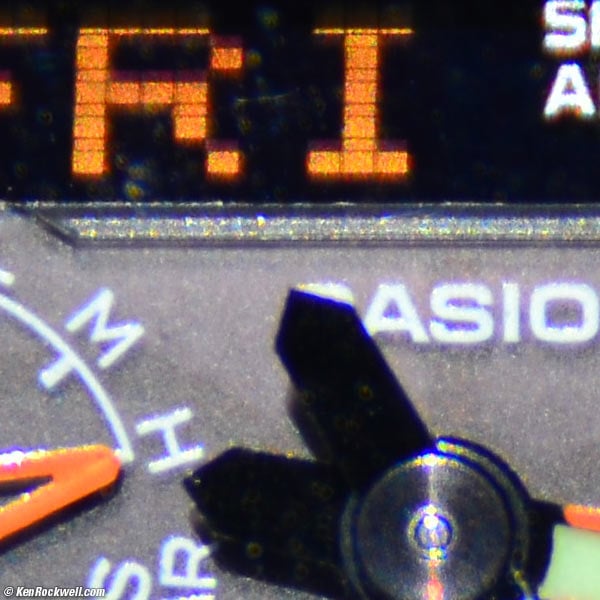
Crop from above image at 100%.
If you really want serious macro, buy a real macro lens, and get one at least 105mm or 200mm.
Maximum and Minimum Apertures performance top
Maximum |
Minimum |
|
18mm |
f/3.5 |
f/22 |
28mm |
f/4 |
f/25 |
50mm |
f/5.3 |
f/32 |
105mm |
f/5.6 |
f/32 |
200mm |
f/5.6 |
f/32 |
300mm |
f/5.6 |
f/32 |
Mechanics and Construction performance top
Nikon 18-300mm VR. enlarge.
The Nikon 18-300mm VR is made the same as most of their midprice consumer lenses: metal mounts, but just about all-plastic otherwise. It will serve its intended purpose well, but break if dropped or banged.
Filter Threads
Plastic.
Hood
Plastic bayonet.
Hood Mount
Plastic.
Barrel Exterior
Plastic.
(one of the two inner barrels that appears when zoomed to long focal lengths is metal)
Zoom Ring
Metal; rubber covered.
Focus Ring
Rubbery plastic.
Depth-of-Field Scale
None.
Internals
Mostly plastic.
Aperture Ring
None.
Mount
Dull-chromed brass.
Markings
Paint.
Mounting Index Dot
White plastic ball.
Identity Plate
Metal-look plastic.
Serial Number
Sticker glued into a recess on the bottom of the lens.
US Model Signified by
"US" prefix to serial number.
Rain seal at mount
Yes.
Noises When Shaken
Mild clunking.
Made in
Thailand.
Sharpness performance top
Warning 1: Image sharpness depends more on you than your lens.
Warning 2: Lens sharpness doesn't mean much to good photographers.
With those caveats, the Nikon 18-300mm VR is as expected: pretty darn good for a lens with such a huge zoom range.
As seen on a 16 MP D7000
At 18mm
It's super-sharp in the center, and slightly blurry in the corners.
Laudably, it is just as good at every aperture.
At 28mm
It's super-sharp in the center, and slightly softer in the corners at f/4.
By f/5.6, everything is super-sharp.
At 50mm
It's super-sharp in the center, and slightly blurry in the corners due to what looks like curvature of field.
The corners improve as stopped down.
At 105mm
It's super-sharp in the center, and somewhat softer in the corners from what looks like curvature of field.
The corners improve as stopped down.
At 200mm
It's slightly softer at f/5.6, and somewhat softer in the corners.
By f/8, it's super-sharp everywhere.
At 300mm
It's slightly softer at f/5.6, and somewhat softer in the corners.
By f/8, it's super-sharp, with slightly softer corners.
It's still sharper than cropping from the 200mm end of the 18-200mm.
Sounds and Noise performance top
It works silently.
Autofocus makes only a slight sliding plastic sound, and VR is inaudible unless you hold the lens to your ear. This is much better than earlier VR systems, which could sound like running water if you listened closely.
Spherochromatism performance top
I see no spherochromatism.
Spherochromatism, sometimes mistakenly called "color bokeh" by laymen, is a minor aberration which can add slight color fringes to out-of focus highlights.
Sunstars performance top
With its rounded 9-bladed diaphragm, the Nikon 18-300 rarely makes sunstars on brilliant points of light.
At the smallest apertures, it sometimes makes 18-pointed stars on very brilliant points of light.
Survivability performance top
The Nikon 18-300mm VR is mostly plastic.
Hit it too hard, and that's the end of it.
The good news is that if you drop it and it breaks into two pieces (front and back will separate), Nikon's service department usually can repair it for much less than buying a new lens.
The 18-300 is loaded with dedicated electronics. If the AF or VR motors die and Nikon can't supply parts, those features will be dead.
Since the electronics are made with lead-free solder, expect this lens to die in about ten years due to tin whiskers forming. (more about this from NASA here, here and here (page 41).)
Zooming performance top
When zoomed to 300mm, the Nikon 18-300 gets very long:
Nikon 18-300 zoomed to 300mm.
The zoom ring is very well laid out, with a constant logarithmic distribution at about 2 cm/octave.
It moves smoothly at every setting, although it's a bit stiff and always requires two firm fingers.
It does allow very precise setting at the wide end, something missing in many zooms who crowd the wider focal lengths too close together.
If you point the lens directly up or down, it will be stiffer as you're trying to lift half the lens.
Mine has no "creep" if pointed up or down.
I don't use the zoom lock at 18mm. My 18-300 doesn't creep. If it did, I find it more work to unlock the lock each time anyway. When locked, it shows an orange dot.
Usage top
Intro Specs Performance Usage Compared Recommendations More
M/A - M Switch
Nikon goofed. This switch is supposed to be labeled "A - M."
The "M/A" position means autofocus. It's called "M/A" because you also can focus manually simply by grabbing the focus ring in this position.
The "M/A" position means autofocus. It's called "M/A" because back in the old days, when Nikon had almost caught up to Canon who had been doing this for ten years before, Nikon was trying to show off that you could focus manually while in the AF position.
Paint over the extra M if you're easily confused.
VR
Leave VR ON.
Even on a tripod, VR still helps overcome tripod wiggle.
I'd turn VR off for time exposures on a tripod, and leave it on for al normal shooting.
Use NORMAL all the time.
ACTIVE is only if you're shooting from a moving platform, for instance, shooting from a helicopter, the back of a motorcycle or out the door of a moving vehicle.
Compared top
Intro Specs Performance Usage Compared Recommendations More
See Nikon 18-200 vs. 28-300 vs. 18-300 for details.
In short, forget the 28-300mm (FX) lens for DX because you lose the wide end, and while this 18-300mm isn't that super-duper sharp at 300mm, it's still sharper than cropping from the 200mm end of the 18-200 VR.
Nikon 18-200 VR DX, 28-300 VR and 18-300 VR DX. bigger.
Recommendations top
Intro Specs Performance Usage Compared Recommendations More
This is a great lens, but it's OBSOLETE. Get the newer, smaller 18-300mm f/3.5-6.3 VR instead.
The Nikon 18-300mm VR can replace the combination of 18-55mm VR and 55-300mm VR lenses in one lens.
This one-lens 18-300mm VR solution weighs as much as both other lenses combined, but in exchange for not needing to change lenses between ranges, costs twice as much as the pair.
Don't use this 18-300 on FX or 35mm cameras. It will never fill the frame on 35mm, and you'll only be using the small central area of the FX frame and viewfinder. For FX and 35mm, use the 28-300 VR.
For DX cameras, this lens is an easy recommendation. There is nothing on Earth like this lens. Nothing else covers this huge range with VR and instant manual-focus override. Mud brands like Tamron usually offer cheap copies, sometimes with even broader zoom ranges, but they usually lack full-time manual focus override or good VR, and certainly lack mechanical quality and often lack future compatibility with new Nikon cameras.
This Nikon 18-300mm VR is a big, competent lens. I prefer the smaller 18-200 VR, but if you really need 300mm instead of 200mm, then this 18-300mm VR is your lens. See Nikon 18-200 vs. 28-300 vs. 18-300 for more details.
I prefer a smaller lens over having to carry a bigger lens all the time just for the few times I need 300mm. Most people will jump at the chance to get out to 300mm with a twist of the wrist. Personally, carrying a lens this big for what are supposed to small DX cameras seems silly to me, but most people are going to prefer this lens. Just be careful: what seems not too heavy when first opening your box from Adorama gets a lot heavier after carrying it around your neck all day.
In the defense of this lens' size, I have carried it all day, even chasing my kids inside the slides and climbing things at my local McDonalds, and I lived — but I only used the wide settings that would have been just as well served from my smaller lenses.
Katie climbing, 07 July 2012. (Nikon D7000, Nikon 18-300mm VR at 24mm, program auto gave f/3.8 at 1/125 at Auto ISO 6,400, Matrix meter, STANDARD Picture Control at +1 Saturation, 6 sharpening, A3 AWB.) bigger.
I licenced this image to McDonalds, and they used it on a BILLBOARD. Enough said?
Ryan, Katie and Dada sliding down the slide, 07 July 2012. (Nikon D7000, Nikon 18-300mm VR at 25mm, program auto gave f/4 at 1/125 at Auto ISO 2,000, Matrix meter, STANDARD Picture Control at +1 Saturation, 6 sharpening, A3 AWB.) bigger.
It's a big lens on a small camera, and if you really need to cover 18-300mm in one lens, it does a fine job. It's at its weakest at the long end of the range, but still the best there is in an ultrazoom. The 70-300 VR isn't any better at the long end; if you need significantly better performance at the long end, you'll need the 80-200mm or 70-200 VR II or fixed lenses instead. At 200mm, my NIKKOR-Q 200mm f/4 from 1970 is sharper than any of these zooms, and sells for only about $75!
Zooms are still tradeoffs. This superzoom is the world's best for its range, but if you're a pixel-counter, fixed lenses are better at the long end.
Deployment
I'd leave either a 77mm Nikon Clear (NC - UV) filter, or a 77mm Hoya Super HMC UV on the lens at all times.
I would leave the hood at home.
If I was working in nasty, dirty areas, I'd forget the cap, and use an uncoated 77mm Tiffen UV filter instead. Uncoated filters are much easier to clean, but more prone to ghosting.
More Information top
Intro Specs Performance Usage Compared Recommendations More
Help me help you top
I support my growing family through this website, as crazy as it might seem.
The biggest help is when you use any of these links when you get anything, regardless of the country in which you live. It costs you nothing, and is this site's, and thus my family's, biggest source of support. These places have the best prices and service, which is why I've used them since before this website existed. I recommend them all personally.
If you find this page as helpful as a book you might have had to buy or a workshop you may have had to take, feel free to help me continue helping everyone.
If you've gotten your gear through one of my links or helped otherwise, you're family. It's great people like you who allow me to keep adding to this site full-time. Thanks!
If you haven't helped yet, please do, and consider helping me with a gift of $5.00.
As this page is copyrighted and formally registered, it is unlawful to make copies, especially in the form of printouts for personal use. If you wish to make a printout for personal use, you are granted one-time permission only if you PayPal me $5.00 per printout or part thereof. Thank you!
Thanks for reading!
Mr. & Mrs. Ken Rockwell, Ryan and Katie.
Home Donate New Search Gallery Reviews How-To Books Links Workshops About Contact
